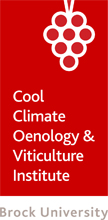Grape Preharvest Monitoring Program
Importance to the Grape and Wine Industry
The Cool Climate Oenology and Viticulture Institute (CCOVI) in collaboration with the Grape Growers of Ontario are sampling and testing grape samples leading up to the commercial harvest. Preharvest berry sampling and analysis is an important initiative. Like many of the other world class wine growing regions, the Niagara Peninsula is subject to large climatic variations from year to year and grape maturity is uniquely specific to each vintage, cultivar, and terroir. Therefore, it is important to track the development of the fruit composition of key grape varieties across the region to assist in determining and scheduling the time to harvest. Until now, there has not been a ‘third party’ source of information available to the grape and wine community to provide timely information on the current status of grape berry development in terms of soluble solids, titratable acidity, pH, and acetic acid across the Niagara Peninsula. These parameters are important to grape growers and processors in making crucial viticulture and harvesting decisions that are fundamental to final grape and wine quality. This initiative is supported by funding through Agriculture and Agri-Food Canada’s (AAFC) Developing Innovative Agri-Products initiative and the Ontario Ministry of Research and Innovation's (MRI) Ontario Research Fund, which support industry-led research and innovation. This project is a collaboration between AAFC, MRI, the Grape Growers of Ontario and Brock’s CCOVI and is part of CCOVI’s heightened emphasis on outreach to the grape and wine industry.
Description of the Project
The varieties chosen for this project are the four most common vinifera varieties planted in the Niagara Peninsula appellation which include Riesling, Chardonnay, Cabernet Franc, and Cabernet Sauvignon. For each variety, four sites will be selected that are representative of different crop sizes per acre. Two of the sites will be west of the Welland canal and the other two sites will be located east of the canal. Therefore, the sampling will try to account for geographical differences as well as vineyard management rationales. The viticulturist from CCOVI will collect samples on a weekly basis. Cluster samples (20/block) will be collected to account for within cluster variation in berry ripeness. Sampling methodology will be consistent for all blocks. Clusters will be sampled in a grid-like pattern and taken from different positions of the canopy and on opposite sides of the row to ensure a representative sample. The fruit will be immediately analyzed by CCOVI Analytical Services for Brix (°Brix using an Abbe bench top refractometer), titratable acidity (titration using NaOH to an end-point of pH 8.2), pH (using a Corning pH meter), and acetic acid (Megazyme acetic acid enzyme assay kit). This information will be available weekly in PDF format posted to the CCOVI website so that the maturation process can be tracked leading up to harvest and the current fruit composition of these varieties can be conveyed to the grape and wine industry. The harvest information will also be posted through the OMAFRA website which will link to their crop report. All grower information will remain confidential to protect their anonymity.


